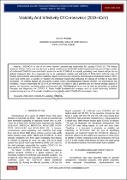| dc.contributor.author | Samuel, Mwesige | |
| dc.date.accessioned | 2023-08-18T14:03:11Z | |
| dc.date.available | 2023-08-18T14:03:11Z | |
| dc.date.issued | 2020-05 | |
| dc.identifier.issn | 2394-4404 | |
| dc.identifier.uri | https://ir.sun.ac.ug//handle/123456789/82 | |
| dc.description.abstract | Abstract:
2019-nCoV is one of the seven human coronaviruses responsible for causing COVID-19. The disease started in Wuhan China and was declared a global pandemic by the World Health Organization because of high number of confirmed COVID-19 cases and deaths across the world. COVID-19 is a rapidly spreading novel disease and yet has no defined treatment plan. It is imperative for us to understand viability and infectivity of 2019-nCoV with the hope of finding interventional and treatment solutions. Based on behavioral similarity and biological relatedness between 2019-nCoV and SARS-CoV, a number of viability and infectivity factors that influence the spread of COVID-19 have been elucidated. The viability factors are viral genes, protein factors and metrological features (fomites, low temperatures low humidity). Factors responsible for 2019-nCoV infectivity are virion N and S proteins and the human biology aspects of gender, sex hormones, sex-linked genes and immune cells. The biological factors can be used as biomarkers to develop therapies and diagnostics for COVID-19. Public health interventional strategies such as social distancing, isolation, contact tracing and use of facemasks should be encouraged to break COVID-19 transmission chain. | en_US |
| dc.description.sponsorship | None | en_US |
| dc.language.iso | en | en_US |
| dc.publisher | International Journal of Innovative Research and Advanced Studies (IJIRAS) | en_US |
| dc.subject | Keywords: 2019-nCoV, COVID-19, Viability, Infectivity | en_US |
| dc.title | Viability And Infectivity Of Coronavirus (2019-nCoV) | en_US |
| dc.type | Article | en_US |

